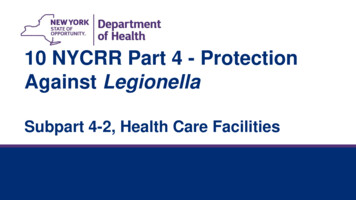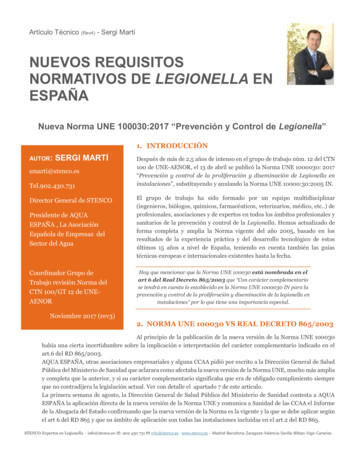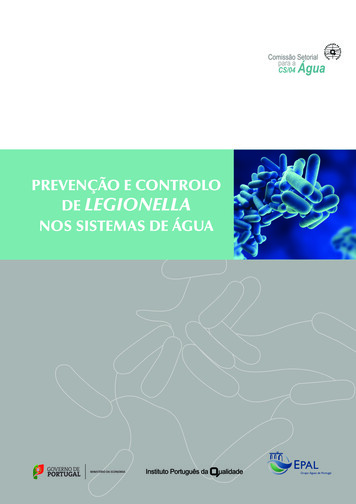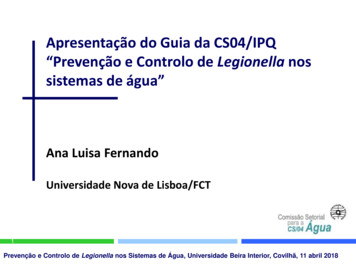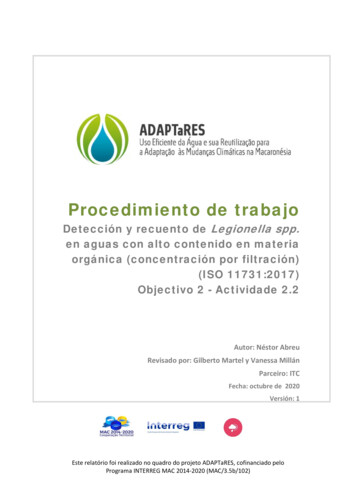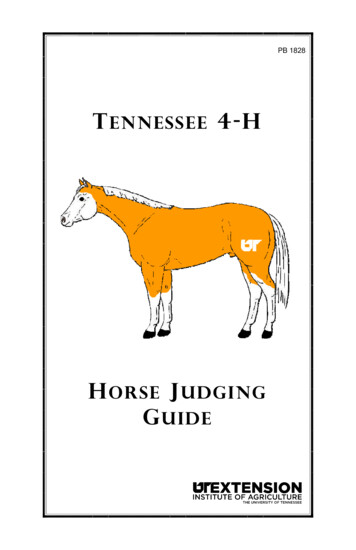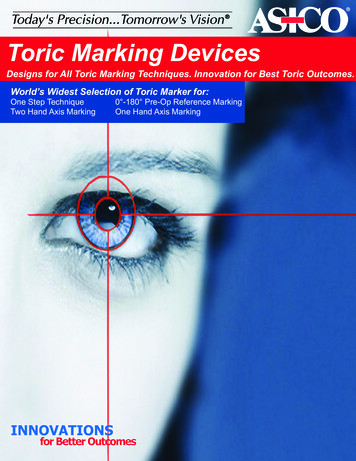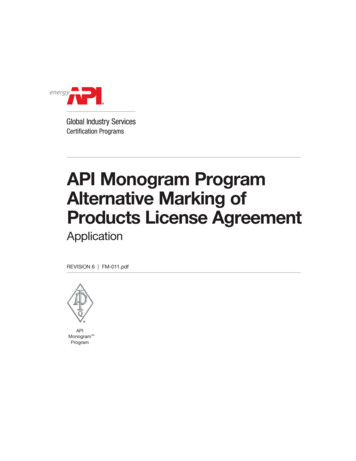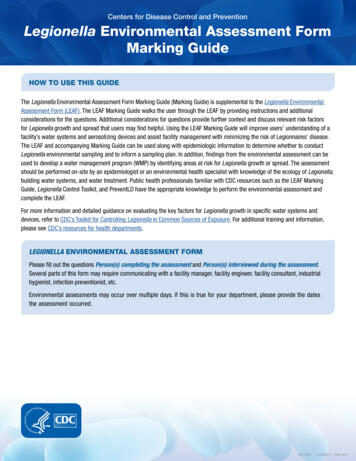
Transcription
Centers for Disease Control and PreventionLegionella Environmental Assessment FormMarking GuideHOW TO USE THIS GUIDEThe Legionella Environmental Assessment Form Marking Guide (Marking Guide) is supplemental to the Legionella EnvironmentalAssessment Form (LEAF). The LEAF Marking Guide walks the user through the LEAF by providing instructions and additionalconsiderations for the questions. Additional considerations for questions provide further context and discuss relevant risk factorsfor Legionella growth and spread that users may find helpful. Using the LEAF Marking Guide will improve users’ understanding of afacility’s water systems and aerosolizing devices and assist facility management with minimizing the risk of Legionnaires’ disease.The LEAF and accompanying Marking Guide can be used along with epidemiologic information to determine whether to conductLegionella environmental sampling and to inform a sampling plan. In addition, findings from the environmental assessment can beused to develop a water management program (WMP) by identifying areas at risk for Legionella growth or spread. The assessmentshould be performed on-site by an epidemiologist or an environmental health specialist with knowledge of the ecology of Legionella,building water systems, and water treatment. Public health professionals familiar with CDC resources such as the LEAF MarkingGuide, Legionella Control Toolkit, and PreventLD have the appropriate knowledge to perform the environmental assessment andcomplete the LEAF.For more information and detailed guidance on evaluating the key factors for Legionella growth in specific water systems anddevices, refer to CDC’s Toolkit for Controlling Legionella in Common Sources of Exposure. For additional training and information,please see CDC’s resources for health departments.LEGIONELLA ENVIRONMENTAL ASSESSMENT FORMPlease fill out the questions Person(s) completing the assessment and Person(s) interviewed during the assessment.Several parts of this form may require communicating with a facility manager, facility engineer, facility consultant, industrialhygienist, infection preventionist, etc.Environmental assessments may occur over multiple days. If this is true for your department, please provide the datesthe assessment occurred.08/17/2022CS 328976-B / PRINT ONLY
FACILITY CHARACTERISTICSPurpose of Questions 1–19: The growth of Legionella is largely dependent on the building water system and fixture characteristics,which include type, size, complexity, and associated devices (e.g., cooling tower). Persons at increased risk of Legionnaires’ diseasemay be more likely to be present at certain facility types, such as healthcare or senior living settings. Providing this information givespublic health officials an idea of the possible level of risk of Legionella growth and spread. Consult with the facility’s maintenance ordesign professionals when needed.1. Is this a healthcare facility or facility with skilled nursing care (e.g., hospital, long term care/rehab/skilled nursingfacility, clinic), or an assisted or senior living facility? Select Yes or No. If unsure, consult with the facility leader(s). If any health care is provided at the facility, then select Yes.If Yes is selected, skip to Question 2 and complete Appendix A.If No is selected, select all facility types that are applicable to the facility you are investigating.If the facility type is not listed, check Other and provide a brief description of the facility on the line provided.2. Total number of buildings on the premises and Total number of buildings being assessed: Write the total number of buildings on the premises on the line provided.Write the total number of buildings being assessed on the premises on the line provided.Additional Considerations: Total buildings assessed will likely be based on case epidemiology (i.e., water systems and devicesthat people with Legionnaires’ disease were exposed to). Keep in mind that if a person spent the entire 14 days prior to illnessonset (i.e., the entire exposure period) in a single room, then at a minimum the areas under investigation should include theentire water distribution system that serves that room, as well as any devices using water. If other areas are subject to the sameconditions (e.g., no WMP, similar water quality parameters), then they should be considered for inclusion, as well.3. Total number of rooms that can be occupied overnight (e.g., patient rooms, hotel rooms): Write the total number of rooms that can be occupied overnight (e.g., patient rooms, hotel rooms) on the line provided.This can help provide an estimate of the facility size and the number of people who may have been exposed to Legionella.4. Does occupancy vary throughout the year? Select Yes if there is a noticeable occupancy trend in relation to the seasons. Select all seasons with the lowest occupancy.Select No if there is no noticeable occupancy trend, and skip to Question 6.Additional Considerations: Reduced occupancy can lead to reduced water flow. Slowly moving or stagnant water increaseswater age, which provides opportunities for Legionella growth. Increased water age also contributes to disinfectant residualloss and water temperatures favorable for Legionella. Please note any interventions in Question 7 to address occupancy-relatedwater stagnation.5. Are any occupant rooms taken out of service (e.g., annually for low season, routinely for inventory, permanently forreuse as storage or administrative purposes)? Select Yes if rooms are closed during times of reduced occupancy or for other reasons describe which rooms are closed andwhere they are located. Select No if all rooms always remain in service.Additional Considerations: Note location of rooms taken out of service or unoccupied, as those can result in areasof stagnation without appropriate intervention. The purpose and use of some occupant rooms may have changed2 CDC Legionella Environmental Assessment Form Marking Guide www.cdc.gov/legionella/wmp/control-toolkit
(e.g., from a patient room to an office space). Determine if associated water piping in the rooms was capped off to prevent deadlegs. Note the location of identified case rooms in relation to rooms taken out of service or unoccupied. Identify any interventionsin Question 7 to address potential water stagnation.6. Did the facility recently experience (i.e., last 12 months) a period of prolonged, reduced occupancy,or a building closure? Select Yes or No. If unsure, consult with a facility manager.If Yes is selected, describe which rooms or buildings the reduced occupancy or closure impacted and where they are located.Additional Considerations: The amount of time required for stagnant water to increase the risk of Legionella growth varies bybuilding water system. In general, as occupancy decreases, potential for water quality issues increases. There is not scientificconsensus about how to define prolonged stagnation. Prolonged stagnation events commonly occur due to seasonality,construction activities, or other events. Water age is a key factor in Legionella growth and increases with stagnation. There areways to control water age and potential Legionella growth, discussed in Question 7.7. Describe any interventions taken as a result of building occupancy changes or occupant rooms taken out of service(e.g., flushing, hyperchlorination): If interventions take place to address issues such as water stagnation or water quality issues (e.g., Legionella growth) duringperiods of reduced occupancy or closures, describe them on the lines provided.Additional Considerations: To control Legionella growth during times of water stagnation, facilities may introduce flushingor remediation with disinfectant. Flushing removes old water from the system and replaces it with fresh water containingdisinfectant. Note that flushing uses the routine building water supply, and disinfectant residual will not exceed that which isprovided by the supply water. Remediation (e.g., hyperchlorination) is an action taken to reduce Legionella growth in responseto control measures, such as routine Legionella test results, that persistently exceed control limits or to events that pose animmediate risk to control of building water systems (e.g., building related closures, reduced occupancy). Note that remediationinvolves addition of disinfectant beyond the levels provided in the routine water supply. Thermal remediation, or “super heating,”is not recommended for building water systems. The CDC Legionella Control Toolkit provides more details on control methods.8. Average length of stay for occupants: Select one of the stay lengths listed.Additional Considerations: Longer stays may correspond to increased risk of exposure to Legionella. For example, occupantsmay be more likely to shower repeatedly and use recreational water features in a tourist destination hotel with longer averagestays than an overnight accommodation at a roadside hotel.9. Does the facility have emergency water systems (e.g., fire sprinklers, safety showers, eye wash stations)? Select Yes or No. If unsure, consult with the facility manager or engineer.If Yes is selected, select whether the systems are regularly tested by a professional through methods like sprinkler headflow tests. If Yes is selected, describe how frequent the emergency water systems are tested and provide the date of the last test.Additional Considerations: Fire sprinklers typically have a backflow preventer to prevent stagnant water in the sprinklersystem from flowing into the other potable water systems while other emergency water systems (e.g., safety showers, eye washstations) may not. If an emergency sprinkler system was not in use or tested during the exposure period for cases, and thereis backflow prevention in place, it typically is not necessary to evaluate that system further. Consider safety showers and eyewash stations that are not routinely flushed as a potential stagnation point, especially if they are connected to the potable watersystem that serves other areas under investigation.3 CDC Legionella Environmental Assessment Form Marking Guide www.cdc.gov/legionella/wmp/control-toolkit
10. Are there any cooling towers or evaporative condensers on the facility premises? Select Yes or No. If unsure, consult with the facility manager or engineer.If Yes is selected, also complete Appendix B.Additional Considerations: For more information on cooling tower design, please refer to the CDC Legionella Control Toolkit.11. Are there any hot tubs, whirlpool spas, or hydrotherapy spas on the facility premises? Select Yes or No. If unsure, consult with the facility manager or engineer.If Yes is selected, also complete Appendix C.Additional Considerations: Please consider jetted bathtubs as a potential exposure source, especially in healthcare settings. Allthese devices have the potential to generate aerosols when in use. Components that do not drain fully between uses provide anopportunity for biofilm development. If infrequently used, these devices may also present potential stagnation points.12. Are there any decorative fountains, misters, or water features on the facility premises? Select Yes or No. If unsure, consult with the facility manager or engineer.If Yes is selected, also complete Appendix D.Additional Considerations: Decorative fountains should not be operated in areas intended for use by persons at increased riskof Legionnaires’ disease, such as healthcare facilities. All decorative fountains produce aerosols. Disinfectant residual can bedepleted quickly as the water aerosolizes, and it is not uncommon for decorative fountains to lack important control measuressuch as supplemental disinfectant.13. Does the facility have centralized humidification (e.g., on air-handling units) or any room humidifiers? Select Yes or No. If unsure, consult with the facility manager or engineer.If Yes is selected, describe the location in terms of area served in addition to how they are operated on the lines provided.Additional Considerations: Humidifiers are devices capable of producing aerosols containing Legionella and have beenassociated with outbreaks. Humidifiers and associated equipment should be properly maintained (e.g., cleaning). Multiple typesof humidifiers (e.g., heated element and steam-type, portable, portable impeller) exist with different operation and maintenancerequirements. Consult the CDC Legionella Control Toolkit or ASHRAE Guideline 12 for additional information.14. Does the facility have ice machines? Select Yes or No. If unsure, consult with the facility manager or engineer. Hotel maps may describe their locations as well.If Yes is selected, indicate the manufacturer, model, and any other pertinent information.Additional Considerations: Ice machines should be maintained according to manufacturer recommendations. Ice machineshave been identified as the source of exposure to Legionella in multiple outbreaks. Ice machines often have carbon filters,which eliminate any disinfectant residual in the water supply. It is common for the compressor to generate heat, resulting intemperatures favorable for Legionella growth in the water lines. At temperatures below 68 F, Legionella becomes dormant butremains present. Ice used for consumption can be aspirated (i.e., when water or ice “goes down the wrong pipe”), especially inhealthcare settings where patients are at increased risk of aspiration. In healthcare settings, ice may also be used for medicalprocedures or equipment and pose atypical routes of exposure to water.15. Does the facility have a landscape irrigation or sprinkler system? Select Yes or No. If unsure, consult with a facility manager or engineer.If Yes is selected, describe the location and operation by time of day and seasonality. Discuss how they are maintained, aswell as other operational details.4 CDC Legionella Environmental Assessment Form Marking Guide www.cdc.gov/legionella/wmp/control-toolkit
Additional Considerations: Sprinkler systems and irrigation systems may generate aerosols. The systems may be less likely tohave Legionella control measures in place, such as flushing to prevent stagnation or remediation following periods when not inuse. In areas intended for use by persons at increased risk of Legionnaires’ disease, such as healthcare facilities, operation shouldbe timed to minimize exposure (e.g., overnight when fewer patients are entering or exiting the building adjacent to sprinklers).16. Has there been any recent (last 6–12 months) or ongoing major construction on or around the facility premises? Select Yes or No. If unsure, consult with a facility manager or engineer.If Yes, also complete Appendix E.Additional Considerations: Construction may result in pressure drops, which can dislodge biofilm containing Legionella.Pressure drops or broken pipes (e.g., water main breaks) can result in intrusion of Legionella or sediment that providesconditions favorable for Legionella growth. In addition, construction may result in the closure of areas of the building watersystem, resulting in potential stagnation.17. Has this facility been associated with a previous legionellosis cluster or outbreak? Select Yes or No. If unsure, consult with a facility manager or health department.If Yes is selected, describe pertinent outbreak information such as number of cases, dates, likely or confirmed source ofLegionella transmission, if identified, root cause(s), and any interventions (immediate and long-term) to prevent recurrence.Review the extent to which previously identified root causes of Legionella growth do or do not persist.18. Does the facility have a water management program (WMP)? Select Yes or No. If unsure, consult with a facility manager, engineer, or infection preventionist.If Yes is selected, answer whether the facility ever tests for Legionella in water samples. If Yes is selected, obtain copies of the test results or summaries going back at least one year.If Yes is selected, describe the water management program and obtain a written copy of the program policy.Additional Considerations: Obtaining a copy of the water management program (WMP) is critical to evaluate the effectivenessof the WMP as part of the investigation. WMPs are an industry standard and recommended by CDC for certain building anddevice types (see the CDC worksheet to identify which buildings and devices should have a WMP: Legionella: Developing aWater Management Program). The lack of a WMP in a facility where recommended is of concern. If the facility lacks a WMP, theinformation gathered through the environmental assessment may be the only available information about the building watersystem and potential Legionella risk.If a WMP is available, it is important to review the WMP and ensure that it clearly identifies the areas at risk of Legionellagrowth and spread, states the control measures to prevent Legionella growth and spread, lists control limits corresponding toeach control measure, and describes corrective actions to take when control limits are not met. The facility should have clearplans for WMP verification (ensuring that the activities are occurring as described in the WMP) and validation (ensuring thatthe WMP activities are effectively controlling Legionella growth). The facility should provide documentation for both verification(e.g., completed checklists and water quality parameter measurements) and validation (e.g., routine environmental sampleresults for Legionella).If routine environmental sampling has been performed for Legionella, review the results, testing method, frequency, andresponsible party. See the Routine Testing Module of the Legionella Control Toolkit for more information about test type andfrequency. Additionally, see Figure 1 for interpretation of routine sampling results.5 CDC Legionella Environmental Assessment Form Marking Guide www.cdc.gov/legionella/wmp/control-toolkit
19. Describe each building that shares water systems (or air systems with centralized humidification), includingthe main facility. In the table provided, fill in all details available on building shared water systems and air systems with centralizedhumidification. Note that under the “Occupancy Rate” column, “High period” is defined as the time in which the occupancyrate is at its highest in the year. “Low period” is defined as the time in which the occupancy rate is at its lowest in the year.Additional Considerations: This table is about gaining a better sense of the facility layout, construction history, and facilityuse to inform the environmental assessment. “Original Construction” indicates age of building piping. “Later Construction”indicates age of building piping and potential complexity of the building water system. “Stories or Levels” indicates complexityof the building water system and is often useful for determining environmental sampling locations. “Occupancy Rate” and “DailyCensus” indicates potential for water stagnation and may be used to determine the number of persons potentially exposed toLegionella. “Use” indicates potential for people at increased risk for Legionnaires’ disease to be exposed to Legionella.Water Supply Source20. What is the source of the water used by the facility? Select all water sources used by the facility. If the water source is not listed, select Other and provide a brief description. If Private well is selected, select the disinfectant used and whether the water is filtered on site.If Public water system is selected, provide the name of supplier, check disinfectant used, and whether the disinfectant hasbeen changed within the past year. Consult with municipal water representative if needed.Additional Considerations:Public water system: Selecting Other as the public water system disinfectant is unlikely. Chlorine and monochloramineare the primary disinfectants used throughout the United States. Use the free chlorine test method to measure availablechlorine and the total chlorine test method to measure monochloramine.Changes to municipal water treatment can change the ecology of the public water system. Public water systems that usemonochloramine often conduct an annual “chlorine burn” where they temporarily switch to chlorine to reduce nitrificationwithin the public water system. A “chlorine burn” can potentially impact building water quality and result in conditionsfavorable for Legionella growth. Please note the timing of any “chlorine burn” as it relates to case epidemiology (i.e., watersystems and devices to which patients were exposed).Private well: Typically, private wells are not treated with a disinfectant such as chlorine or monochloramine; however,private wells often have filtration or other water quality treatment devices on site (e.g., to reduce sulfur and hardness).Water softener regenerative media and pressure tanks can be a potential reservoir for Legionella growth. Additionally, watersofteners and filtration can deplete disinfectant.Other: “Other” sources might include Non-Transient Non-Community Water Systems and Transient Non-Community WaterSystems. Per the EPA: Non-Transient Non-Community Water System (NTNCWS): A public water system that regularly supplies water to atleast 25 of the same people at least six months per year. Some examples are schools, factories, office buildings, andhospitals that have their own water systems. Transient Non-Community Water System (TNCWS): A public water system that provides water in a place such as agas station or campground where people do not remain for long periods.6 CDC Legionella Environmental Assessment Form Marking Guide www.cdc.gov/legionella/wmp/control-toolkit
21. Have there been any pressure drops, boil water advisories, or water disruptions (e.g., water main break) to the facilityin the past 6 months (whether in the public water system before the point of entry and/or on facility property)? Select Yes or No. If unsure, consult with the facility manager, engineer, or municipal water representative.Is Yes is selected, describe the incident and which building(s) or part of building(s) were affected.Additional Considerations: Changes in water pressure and water main breaks may dislodge biofilm containing Legionella,increase sediment that promotes Legionella growth, or result in intrusion of Legionella into the building water supply.22. Does the facility monitor incoming water parameters (e.g., residual disinfectant, temperature, pH)? Select Yes or No. If unsure, consult with the facility manager or engineer.If Yes is selected, obtain copies of the logs and describe the ranges for disinfectant residual, temperature, and pH enteringthe facility.Additional Considerations: Monitoring incoming water quality is a critical component of a building water managementprogram. It allows facility managers to identify incoming water quality trends over time and make appropriate adjustments tothe WMP. Historical readings are relevant when comparing to conditions observed during the environmental assessment. Reviewvalues across seasons if possible, as water quality parameters may vary according to ambient temperatures and any routinechanges in water treatment (e.g., annual “chlorine burns” described above in Question 20). If there is a clear time frame forpotential exposures associated with cases, review water quality parameters for that time (e.g., if there were multiple cases inthe first week of December, review water quality parameter values for the month of November to see if changes were madepreceding the cases).Premise Plumbing System23. Are cisterns and/or water storage holding tanks used to store potable water before it’s heated? Select Yes or No. If unsure, consult with a facility manager or engineer.Additional Considerations: Water storage tanks holding potable water can increase water age, resulting in a decrease indisinfectant. Additionally, improperly insulated tanks or cisterns exposed to sunlight or heat can increase water temperature intothe favorable range for Legionella growth (77–113 F, 25–45 C). Storage tanks and cisterns can experience irregular flow dueto the lack of complete water mixing within the tank or cistern. Recirculation pumps may be installed inside storage tanks andcisterns to ensure proper water mixing and ultimately reduce water aging and avoid temperature stratification.24. Are water softeners used on incoming water? Select Yes or No. If unsure, consult with a facility manager or engineer.If Yes is selected, briefly describe whether they are installed on the hot, cold, or both water systems on the line provided.Additional Considerations: Water softeners can deplete disinfectant residual. Try to measure disinfectant residual prior to thewater softener and just after the water softener to identify any impact on disinfectant residual.25. Are water filters used? Select Yes or No. If unsure, consult with a facility manager or engineer.Is Yes is selected, describe where the filters on the water system are installed. In addition, describe the filter type andmanufacturer/model.Additional Considerations: Some filters can deplete disinfectant (e.g., carbon filtration) and are potential reservoirs formicrobial growth. It’s important to note the location of these filters because a centrally located water filter may affect the entirebuilding’s water quality. For example, carbon filters located near the building’s water point of entry may result in water without7 CDC Legionella Environmental Assessment Form Marking Guide www.cdc.gov/legionella/wmp/control-toolkit
a detectable disinfectant residual throughout the building, creating conditions favorable for Legionella growth. Point-of-usemicrobial filters used to filter for Legionella (with an effective pore size of 0.2 microns or less that comply with the requirementsof ASTM F838) typically do not impact disinfectant levels, although they may result in reduced water flow and increased waterage. Follow manufacturer recommendations on how often filters should be replaced and review documentation to ensuremanufacturer recommendations are being followed.26. Is there a recirculation system (a system in which water flows continuously through the piping to ensure constant hotwater to all endpoints) for the hot water? Select Yes or No. If unsure, consult with a facility manager or engineer.If Yes is selected, describe where the recirculation system runs and what the delivery/return temperatures are, if measured.Additional Considerations: A recirculation system decreases hot water stagnation and is a common Legionella risk reductionmeasure through temperature control. Buildings without hot water recirculation are at increased risk of Legionella growth ifthe water age of the hot water system is not controlled. It may be difficult to measure the temperature of the water prior toreheating at the water heater if there is not a sampling port. If there is not a sampling port, measure the water temperature atthe most distal fixture on the recirculating system (the fixture furthest from the hot water heater along the distribution system).Note the difference between the water supply temperature just after being heated and the return temperature prior to reheating.Deviations between the two temperatures should be noted as they indicate water age and potential stagnation (i.e., as hotwater recirculates faster and more efficiently, the temperature differential should decrease). The Legionella Control Toolkitrecommends that recirculating temperatures do not drop below 120 F (49 C). If anti-scald regulations require that hot waterbe delivered at lower temperatures, other controls may be necessary, such as thermostatic mixing valves located adjacent tofixtures (see Question 27).27. Are thermostatic mixing valves used? Select Yes or No. If unsure, consult with a facility manager or engineer.If Yes is selected, describe where the valves are located on the line provided. In addition, describe the temperature setpoint(s).Additional Considerations: Thermostatic mixing valves (i.e., temperature valves) are used to blend hot and cold water toprevent scalding. There are two types of mixing valves: master mixing valves and point-of-use valves. Master mixing valves arecentrally located after the water heater, and point-of-use mixing valves are located at the individual fixture level. Thermostaticmixing valves are recommended to be installed as close as possible to fixtures to prevent scalding while permitting circulatinghot water temperatures above 120 F (49 C). Master mixing valves may result in temperatures throughout the building watersystem that are favorable for Legionella growth. If a facility is unable to maintain hot water temperatures throughout the systemto prevent Legionella growth, then other control measures will be critical, such as maintaining presence of disinfectant residualin the hot water.28. How is the hot water system configured to deliver hot water to each building? Fill in the table provided.Additional Considerations:Type of System (e.g., instantaneous heater, water heater with a storage tank, solar heating): There are two generaltypes of water heaters: 1) instantaneous and 2) water heater with a storage tank. Instantaneous water heaters do not storewater, which is a Legionella growth control measure. Water heaters with a storage tank store water and maintain water at aset temperature until the water is used, which increases water age. Water heaters with storage tanks can have temperaturestratification (i.e., layers of varying water temperature) resulting in potential temperatures in the favorable range forLegionella growth (77–113 F, 25–45 C) despite having a higher temperature set point. Water heaters with storage tankscan also build up sediment and need to be routinely cleaned according to manufacturer recommendations. It is important to8 CDC Legionella Environmental Assessment Form
Legionella environmental sampling and to inform a sampling plan. In addition, findings from the environmental assessment can be In addition, findings from the environmental assessment can be used to develop a water management program (WMP) by identifying areas at risk for Legionella growth or spread.
